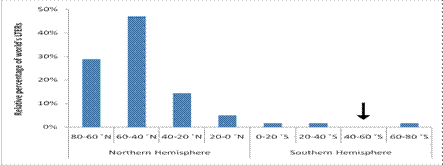The program's philosophy and geographic origin pervades the administrative, educational, institutional and research aspects of our conservation strategies.
Why Sub-Antarctic?
 Until the 20th century, high-latitude ecosystems in southwestern South America remained largely free of direct modern human impact due to their remote location, lack of terrestrial connectivity, and restricted access to areas under control of the Chilean navy. UNESCO Cape Horn Biosphere Reserve includes the Magellanic sub-antarctic evergreen rainforest ecoregion (49-56°S), which was identified as one of the world's 24 most pristine ecoregions by Conservation International. At the beginning of the 21st century, construction of new access roads through primeval forests has increased the connectivity of this region with the mainland, and the Chilean navy is significantly reducing its presence. At the same time, this sub-Antarctic region is facing impending threats from various national and international development projects. The major ones include damming of several important rivers to generate hydroelectric power demanded by industrial growth in central Chile, extension of the network of roads, expanding the salmon farming industry into pristine fjords, lakes and estuaries, increasing unregulated tourism on uninhabited islands, and rapidly spreading exotic species (e.g., the North American beaver and mink).
Until the 20th century, high-latitude ecosystems in southwestern South America remained largely free of direct modern human impact due to their remote location, lack of terrestrial connectivity, and restricted access to areas under control of the Chilean navy. UNESCO Cape Horn Biosphere Reserve includes the Magellanic sub-antarctic evergreen rainforest ecoregion (49-56°S), which was identified as one of the world's 24 most pristine ecoregions by Conservation International. At the beginning of the 21st century, construction of new access roads through primeval forests has increased the connectivity of this region with the mainland, and the Chilean navy is significantly reducing its presence. At the same time, this sub-Antarctic region is facing impending threats from various national and international development projects. The major ones include damming of several important rivers to generate hydroelectric power demanded by industrial growth in central Chile, extension of the network of roads, expanding the salmon farming industry into pristine fjords, lakes and estuaries, increasing unregulated tourism on uninhabited islands, and rapidly spreading exotic species (e.g., the North American beaver and mink).
 The sub-Antarctic region also represents a gap in global monitoring initiatives. We conducted a survey among global LTERs sites by latitude, and found that no official sites were present between 40-60°S. In spite of its outstanding biodiversity and ecosystem attributes, the sub-antarctic ecoregion of South America is located within the only latitudinal range (40-60°S) that completely lacks international long-term ecological research today. We aim to address this with the formation of the new Chilean Long-Term Socio-Ecological Research Network.
The sub-Antarctic region also represents a gap in global monitoring initiatives. We conducted a survey among global LTERs sites by latitude, and found that no official sites were present between 40-60°S. In spite of its outstanding biodiversity and ecosystem attributes, the sub-antarctic ecoregion of South America is located within the only latitudinal range (40-60°S) that completely lacks international long-term ecological research today. We aim to address this with the formation of the new Chilean Long-Term Socio-Ecological Research Network.
Why Biocultural?
Our program's unifying research theme is biocultural conservation, which integrates environmental philosophy, environmental sciences, humanities and the arts in the temperate, sub-Antarctic region of southwestern South America. Today's pressing global environmental problems--climate change, biodiversity losses, scarcity of freshwater and other forms of environmental degradation--stem from cultural, economic and social causes and, therefore must be addressed by coupling scientific and humanistic perspectives to achieve effective conservation and sustainable development practices.
Since the 1980s, leading social and environmental scientists have promoted interdisciplinary approaches to address complex eco-social problems, which have resulted in the development of interdisciplinary fields such as ecological economics and restoration ecology. These new fields have successfully generated concepts like "ecosystem goods and services" and "ecosystem health and rehabilitation," stimulating scientific research, policy development, and conservation strategies. In contrast, the integration of broader cultural and philosophical approaches into sustainable development, and conservation of biological and cultural diversity require new partnerships between ecology, social sciences and humanities. Specifically, there is a pressing need for the integration of ethical values and ecological empiricism, and its incorporation into conservation of biological and cultural diversity.

